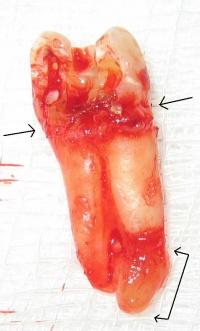Dental abscess: Difference between revisions
| (7 intermediate revisions by 3 users not shown) | |||
| Line 1: | Line 1: | ||
==Background== | ==Background== | ||
[[File:Chronic apical periodontitis (with arrows).jpg|thumb| | [[File:Chronic apical periodontitis (with arrows).jpg|thumb|Maxillary right second premolar after extraction. The two single-headed arrows point to line separating the crown (in this case, heavily decayed) and the roots. The double headed arrow (bottom right) shows the extent of the abscess that surrounds the apex of the palatal root.|200px]] | ||
*Associated with dental caries or nonviable teeth | *Associated with dental caries or nonviable teeth | ||
*Significant erosion of the pulp with bacterial overgrowth | *Significant erosion of the pulp with bacterial overgrowth | ||
| Line 6: | Line 6: | ||
==Clinical Features== | ==Clinical Features== | ||
[[File:Abces dentaire.jpg|thumb|Abscess originating from a tooth that has spread to the buccal space. Above: deformation of the cheek on the second day. Below: deformation on the third day.]] | [[File:Abces dentaire.jpg|thumb|Abscess originating from a tooth that has spread to the buccal space. Above: deformation of the cheek on the second day. Below: deformation on the third day.]] | ||
*Acute pain, swelling, and mild tooth elevation | [[File:Abces parulique.jpg|thumb|A decayed, broken down tooth, which has undergone pulpal necrosis. A periapical abscess (i.e. around the apex of the tooth root) has then formed and pus is draining into the mouth via an intraoral sinus (gumboil)]] | ||
*Acute [[dental pain|pain]], swelling, and mild tooth elevation | |||
*Exquisite sensitivity to percussion or chewing on the involved tooth | *Exquisite sensitivity to percussion or chewing on the involved tooth | ||
*Swelling in surrounding gingiva, buccal, lingual or palatal regions | *Swelling in surrounding gingiva, buccal, lingual or palatal regions | ||
| Line 15: | Line 16: | ||
==Evaluation== | ==Evaluation== | ||
[[File:Abcés dentaire TDM 1.jpg|thumb|CT scan showing a large left tooth abscess with significant inflammation of fatty tissue under the skin.]] | |||
*Clinical evaluation | *Clinical evaluation | ||
*Radiographs | *Radiographs | ||
==Management== | ==Management== | ||
*Analgesia with NSAIDs, | *[[Analgesia]] with NSAIDs, [[opioids]] and/or [[local anesthetics]] | ||
*Dental follow-up within 48 hrs. | *Dental follow-up within 48 hrs. | ||
*Emergent oral surgeon | *Emergent oral surgeon follow-up if complicated (Ludwig's angina, Lemierre's syndrome) | ||
===[[Antibiotics]]=== | ===[[Antibiotics]]=== | ||
{{Dental Abscess Antibiotics}} | {{Dental Abscess Antibiotics}} | ||
===I&D=== | ===[[I&D]]=== | ||
*Can be performed in ED depending on provider comfort or by a dental consultant | *Can be performed in ED depending on provider comfort or by a dental consultant | ||
====Procedure==== | ====Procedure==== | ||
Revision as of 21:52, 22 October 2019
Background
- Associated with dental caries or nonviable teeth
- Significant erosion of the pulp with bacterial overgrowth
Clinical Features
- Acute pain, swelling, and mild tooth elevation
- Exquisite sensitivity to percussion or chewing on the involved tooth
- Swelling in surrounding gingiva, buccal, lingual or palatal regions
- May see small white pustule (parulis) in gingival surface characteristic for abscesses
Differential Diagnosis
Dentoalveolar Injuries
Odontogenic Infections
- Acute alveolar osteitis (dry socket)
- Acute necrotizing ulcerative gingivitis (trench mouth)
- Dental abscess
- Periapical abscess
- Periodontal abscess
- Ludwig's angina
- Pulpitis (dental caries)
- Pericoronitis
- Peritonsillar abscess (PTA)
- Retropharyngeal abscess
- Vincent's angina - tonsillitis and pharyngitis
Other
Evaluation
- Clinical evaluation
- Radiographs
Management
- Analgesia with NSAIDs, opioids and/or local anesthetics
- Dental follow-up within 48 hrs.
- Emergent oral surgeon follow-up if complicated (Ludwig's angina, Lemierre's syndrome)
Antibiotics
Treatment is broad and focused on polymicrobial infection
- Amoxicillin-clavulanate 875 mg PO q12 hours x 7-14 days
- Clindamycin 450 mg PO q8 hours x 7-14 days
- Penicillin VK 500 mg PO q6 hours x 7-14 days (frequently prescribed but no longer recommended as monotherapy)
- Ampicillin/Sulbactam 3g IV q6 hours x 7 days
I&D
- Can be performed in ED depending on provider comfort or by a dental consultant
Procedure
- 11 or 12 blade stab incision
- Hemostat blunt dissection +/- packing
See Also
References
- ER Atlas






